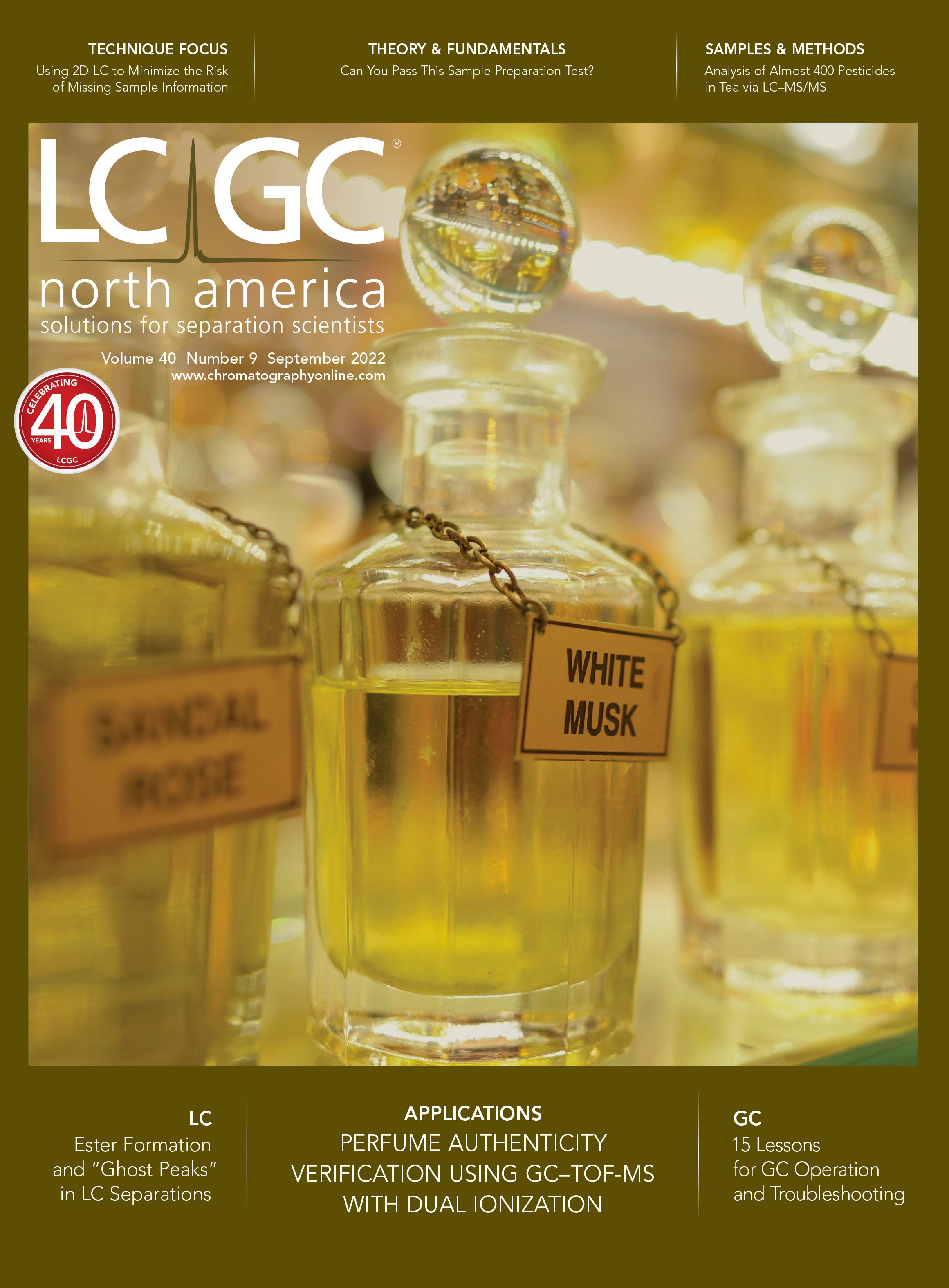Getting “Under the Hood” of Gas Chromatography: Lessons from ChromTalks 2022
The gas chromatography (GC) session of the 2022 ChromTalks event, sponsored by LCGC and ChromAcademy, brought together six world-renowned gas chromatography experts who discussed some of the most important lessons in troubleshooting and “getting under the hood” of gas chromatography. In this installment, we revisit the 2022 ChromTalks, discussing the most important GC troubleshooting lessons from the symposium.
Speakers in the gas chromatography (GC) session of the ChromTalks 2022 event, sponsored by LCGC and ChromAcademy, provided practical advice for maintaining, optimizing, and troubleshooting sampling, inlets, detectors, data handling, and documentation. They shared key insights about how to get the most out of GC for the most difficult problem solving, carry out the best quantitative analysis, and ensure the highest data integrity (1).
I led off the symposium with a discussion of some hidden errors in sampling and sample preparation, especially in glassware handling, that befall all of our methods, which was discussed in a previous installment of this column (2). Our first two lessons are these:
Lesson 1: Volumetric glassware is not perfect. It has finite uncertainty that must be considered in the development of even the simplest methods.
Lesson 2: Be careful of basic statistics and significant figures when reporting results. We often over-report significant figures and under-report experimental uncertainty, making our results appear better than they actually are.
Now, we discuss highlights from the other five speakers’ talks, and provide information on how you can access the recorded talks online. In my opinion, this was one of the strongest lineups of gas chromatographers in one symposium in recent memory. There was far more takeaway information than we can discuss here, so please access the full session on-demand at ChromAcademy, LCGC’s educational partner, or in the webcast section of the LCGC website (www.chromatographyonline.com).
Jaap de Zeeuw of Creavision, an independent consulting firm and a longtime column and instrumentation wizard with Varian and Restek, discussed “The 10 Most Important Maintenance Points You Need to Know About Your Split/Splitless Injection System.” Hans-Gerd Janssen of Unilever and Wageningen University then discussed “Sample Introduction Methods for Liquid Samples in GC: Classical Volumes and Large Volumes.” Matthew Klee, currently of XO Associates and previously a longtime GC leader at Agilent Technologies, presented “Optimizing the Inlet-to-Column Transition in Gas Chromatography.” Mary Ellen McNally of FMC Corporation followed with “Detecting It All—Keeping Your Response Consistent with Common GC Detectors.” Finally, Gregory Slack of Boston Analytical discussed “Qualifying and Optimizing GC Instruments and Methods in High-Throughput Regulated Laboratories.” The titles alone provide some insight into the most common trouble points in GC: inlets, injection, detectors, data handling, and documentation. A follow-up session at ChromTalks included talks from vendor scientists including Agilent Technologies, CEM/ Lucidity, LECO, and Scion Instruments.
Lesson 3: The inlet is the most difficult part of the instrument to understand and optimize. Jaap de Zeeuw offered over 10 practical tips for optimizing and caring for split/splitless inlets, some of which are highlighted here.
Lesson 4: Take care with the septum and ferrules. Pre-seal ferrules onto the column prior to installation to ensure a secure leak-free seal. Ferrules should be tightened, but not too tight, using modern finger-tight fittings and avoiding wrenches. Use an electronic leak detector for checking for leaks; avoid using soap solutions because these can allow soap to enter, and thus contaminate the system. Beware of inlet contamination by septum particles. Septa are made of the same polymers that make up common stationary phases. Inspect the liner regularly for septum particles. Particles can retain your analytes, generating unwanted retention in the inlet. A septum has about 60 times more polydimethylsiloxane (PDMS) than the whole column. Septum lifetime depends on septum type, temperature, syringe needle, centering of the autosampler, and sample solvent. To minimize problems, use a lower temperature, septum purge, and new generation septa, and make sure to replace them on time. Always have spares of septa and all other changeable parts on-hand for quick replacement.
Lesson 5: Beware of sample size and backflash. The sample matrix can contaminate carrier gas lines and be eluted as ghost peaks, or as a broad baseline drift that cannot be attributed to column bleed. This usually results from backflash generated by injecting too much sample. Interestingly, the sample matrix can also deposit in the split line, causing ghost peaks and possibly changing the split ratio. Backflash is also a possible cause of very broad ghost peaks. Just 1 μL of liquid can generate up to 1 mL of vapor, depending on the solvent and injection conditions used. This can be a greater volume than the glass liner, causing the backflash. Several vendors have injection volume calculators that can help with determining the maximum injection volume, depending on choice of liner, solvent, pressure, and temperature.
Lesson 6: Column positioning and inlet liner geometry are critical. Be sure to know the correct column positioning in the inlet liner. This varies by instrument manufacturer, liner geometry, and injection technique. When performing split injections with wool in the liner, make sure the wool is in the correct position. Use wool in the liner to assure high heat transfer to the sample, while minimizing the temperature drop because of evaporation. Wool also prevents small liquid droplets from reaching the column, and catches impurities such as septum particles. For split injections, use a 4-mm internal diameter (i.d.) liner with glass wool, or a cyclo liner if wool is not used. For splitless injection, a 4-mm i.d. single taper liner with wool at the bottom is recommended. If wool cannot be used, a 4-mm i.d. double taper with cyclo is best, but also more expensive. In a previous installment of this column, I discussed inlet liners (3). If you review that, you will see different recommendations. One challenge that remains with inlet liners is that they should be studied as a part of the method development process. There is no single liner that works best with all samples. To improve the lifetime of a liner, inject less sample, use a lower temperature and cleaner sample, or use backflush techniques.
Lesson 7: “If the column is described as the heart of the chromatographic system, than sample introduction is the Achilles heel.” – Pretorius and Bertsch 1983 (4). Hans Gerd Janssen and co- author Sjaak de Koning discussed sample introduction for liquids using classical and large volumes. There is a wide range of injection techniques available; how do we select one? The main factors to consider include sample concentration, stability, boiling point of solvent and analytes, polarity of the solvent, and injection volume. A decision tree to assist in making the best choice of injection technique was provided in the presentation.
Lesson 8: Understand the impact of solvent and stationary-phase focusing on splitless injections. Peak focusing is very important in sample introduction; we can only get narrow peaks at the end of the column if we introduce narrow peaks at the beginning of the column. Whatever injection technique is used, think about how the analytes are focused at the column head. In stationary-phase focusing, bands are focused by interaction with the stationary phase and is inherent in temperature programming. The cool temperature at the column head traps analyte bands near the head of the column. The second mechanism, solvent focusing, works for volatile analytes. After the injection, a band of liquid solvent is created at the column inlet. As the solvent band evaporates, analytes are concentrated until the solvent band fully evaporates. In a classical split injection, transfer through the inlet is very rapid, so peaks enter the column already focused. Classical splitless injection is a much slower process, requiring peak focusing, either by solvent or stationary phase focusing at the beginning of the run. Hans-Gerd presented several guidelines for splitless injections, including purge-off time, initial oven temperature (keep it 20 degrees or more below the pressure corrected solvent boiling point), and avoiding sample discrimination.
Lesson 9: Try cold injection techniques. Although split and splitless injections are most widely used, programmed temperature vaporization (PTV) injection combines the benefits of split, splitless, and on-column inlets. In short, the sample is injected cold as a liquid into the liner, and analytes are transferred into the column by rapidly heating the inlet. There are three modes: cold split, cold splitless, and solvent elimination, with solvent elimination being the most useful. In solvent elimination, the syringe to liner and liner to column transfers are decoupled. Hans-Gerd provided an overview of how solvent elimination PTV injection can be used to inject both traditional volumes of liquid volumes and large volumes up to hundreds of microliters. An overview of cold injection techniques with references was provided in a recent “GC Connections” column (5).
Lesson 10: Representative sampling is critical if the full sample is to be analyzed, as in untargeted analysis. It is less critical in targeted analysis. Matthew Klee discussed the inlet-to-column transition, including representative sampling, discrimination, droplet formation in the column, liner-versus-column decomposition, and maintenance principles. Regardless of the inlet or detector system, representative sampling is critical if the sample components must be fully characterized, as is the case in untargeted analysis. Representative sampling is not always needed in targeted analysis. To ensure representative injection in an Agilent GC system, install the insulation cup in the oven under the inlet. The inlet temperature causes discrimination, which results in nonrepresentative sampling with sources including pressure surge or liner overload, causing loss of volatile components and too low temperature, which causes loss of less-volatile components. Splitless purge time also influences discrimination with less-volatile components requiring longer purge times.
Lesson 11: Use a tapered liner with glass wool for most liquid injections. Although simple straight liners were recommended in the past, for simplicity, today, a liner with glass wool at the top and a taper at the bottom is recommended for most liquid injections. Wool wipes the needle and prevents septum pieces from falling further into the liner. This helps reduce inlet degradation, which can cause peak splitting or poor peak shapes. Column degradation will generally cause a broad increase in the baseline. If both are present, a “bridge” between the two peaks might be seen. Split peaks also often result from sample condensation in the column; use of a retention gap or uncoated precolumn can ensure that a stable uniform solvent film is formed in a splitless injection. Split peaks commonly result from a mismatch in polarity between the solvent and the stationary phase. Finally, have a routine maintenance schedule that includes septum, liner, baseplate and seal replacement, column trimming and installation, and solvent vent trap replacement.
Lesson 12: Detectors are not just a “black box” at the end of the column. Mary Ellen McNally discussed detectors, with a focus on the fundamentals of how common and selective detectors operate, as well as principles common to detection. Some key practical considerations for all detectors include:
- Avoid temperature fluctuations when placing the instrument. Avoid air conditioning ducts, drafts, vents, and poorly insulated walls. Detectors are very sensitive. Also, allow time for the detector temperature to equilibrate when changed or cooled for maintenance.
- Watch for gas leaks. Gas leaks can seriously degrade performance; for example, diffusion of air into a thermal conductivity detector (TCD) is particularly bad because air has a different conductivity than helium or nitrogen. Use an electronic leak detector to ensure all connections are leak free, and ensure that carrier gas is pure. Carrier gas impurities will cause both elevated baseline and noise.
- Disconnect the column from the detector during column conditioning. This prevents eluents from the conditioning from contaminating the detector.
- Bring the column oven to operating temperature before turning on the detector to prevent condensation buildup in the detector, because the oven heats more rapidly.
- Keep all side panels and covers in place on the instrument during operation to maintain overall thermal stability.
- Scrubbers and moisture traps are recommended to remove contaminants from detector gases, as well as carrier gases.
Lesson 13: Ensure that the detector is clean and equilibrated. In short, for the best detector operation, think cleanliness and equilibration. The detector and system should be contaminant free and given time to equilibrate before use and between runs. Keep the detector running overnight.
Lesson 14: Qualify your instrument at installation, for performance at installation, and ongoing, as according to the standard operating procedure. Gregory Slack closed the session by providing a big-picture overview of challenges in optimizing and qualifying gas chromatographs in high-throughout laboratories. Instrument qualification requires four steps: design qualification, installation qualification, performance qualification, and ongoing calibration and maintenance. Greg emphasized the need for standard operating procedures and documented processes for each step. He recommended using real samples for ongoing qualification.
Lesson 15: Ensure that methods are fully documented, and that all analysts follow them. Greg also provided several examples of investigations and FDA inspection results. A common theme in the inspection results was that written methods and standard operating procedures were either incomplete or not followed. In regulated laboratories, once instruments are qualified, the methods that run on them must be validated, according to regulatory guidance and internal standard operating procedures. A broad audit finding might indicate a problem such as the assay method for the active pharmaceutical ingredient lacking a specificity determination. A more detailed finding might indicate a problem such as the use of a 10.0 μL syringe for a method requiring delivery of 0.2 μL of liquid. The finding might then ask for supportive data to prove that the 10.0 μL syringe can accurately and precisely deliver the 0.2 μL of liquid. This finding provides an appropriate close to this column. Although it is possible that the 10 μL syringe can precisely deliver a given volume, it cannot accurately deliver 0.2 μL given the needle volume alone of approximately 0.5 μL. Our previous speakers discussed sampling and injection; in this case, an injection problem becomes evident in a regulatory inspection. Greg also provided several real-world troubleshooting investigation examples. Interestingly, and independently of the other speakers, he discussed a real-world example involving a poor choice of injection liner.
Conclusion
I was honored to host and speak in the GC session of the ChromTalks 2022 event, “Getting Under the Hood of Chromatography.” These brief summaries only give us a quick look. I invite you to watch these presentations online, they are available on demand, in the webcast section of the LCGC website (www.chromatographyonline.com) or at LCGC’s ChromAcademy—to get a more detailed look “under the hood.”
References
(1) ChromTalks 2022, “Getting Under the Hood of Gas Chromatography,” https://www.mjhlsconnects.com/1920-2/chrom-talks-2022/day-two/ (accessed August, 2022).
(2) N.H. Snow, LCGC North Am. 40(7), 304–308 (2022).
(3) N.H. Snow, LCGC North Am. 40(3), 121–124 (2022).
(4) V. Pretorious and W. Bertsch, J. High Resolut. Chromatogr. Chromatogr. Comm. 6, 64 (1983).
(5) N.H. Snow, LCGC North Am. 37(7), 392–395 (2019).
ABOUT THE AUTHOR
Nicholas H. Snow is the Founding Endowed Professor in the Department of Chemistry and Biochemistry at Seton Hall University, and an Adjunct Professor of Medical Science. During his 30 years as a chromatographer, he has published more than 70 refereed articles and book chapters and has given more than 200 presentations and short courses. He is interested in the fundamentals and applications of separation science, especially gas chromatography, sampling, and sample preparation for chemical analysis. His research group is very active, with ongoing projects using GC, GC–MS, two-dimensional GC, and extraction methods including headspace, liquid–liquid extraction, and solid-phase microextraction. Direct correspondence to: LCGCedit@mmhgroup.com


Sorbonne Researchers Develop Miniaturized GC Detector for VOC Analysis
April 16th 2025A team of scientists from the Paris university developed and optimized MAVERIC, a miniaturized and autonomous gas chromatography (GC) system coupled to a nano-gravimetric detector (NGD) based on a NEMS (nano-electromechanical-system) resonator.
Miniaturized GC–MS Method for BVOC Analysis of Spanish Trees
April 16th 2025University of Valladolid scientists used a miniaturized method for analyzing biogenic volatile organic compounds (BVOCs) emitted by tree species, using headspace solid-phase microextraction coupled with gas chromatography and quadrupole time-of-flight mass spectrometry (HS-SPME-GC–QTOF-MS) has been developed.
Fundamentals of Benchtop GC–MS Data Analysis and Terminology
April 5th 2025In this installment, we will review the fundamental terminology and data analysis principles in benchtop GC–MS. We will compare the three modes of analysis—full scan, extracted ion chromatograms, and selected ion monitoring—and see how each is used for quantitative and quantitative analysis.














